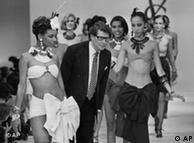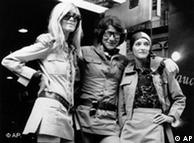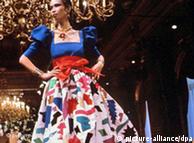Yves Saint Laurent, 71, Is Dead; A Giant of Couture for 45 Years

Yves Saint Laurent at the end of his fall show in Paris in 1987. More Photos >
Yves Saint Laurent, who exploded on the fashion scene in 1958 as the boy-wonder successor to Christian Dior and endured as one of the best-known and most influential couturiers of the second half of the 20th century, died on Sunday at his apartment in Paris. He was 71.
Multimedia
Readers' Comments
Share your thoughts on Yves Saint Laurent.
His death was confirmed by Dominique Deroche, a spokeswoman for the Pierre Bergé-Yves Saint Laurent Foundation.
During a career that ran from 1957 to 2002 he was largely responsible for changing the way modern women dress, putting them into pants both day and night, into peacoats and safari jackets, into “le smoking” (as the French call a man’s tuxedo jacket), and into leopard prints, trench coats and, for a time in the 1970s, peasant-inspired clothing in rich fabrics.
Mr. Saint Laurent often sought inspiration on the streets, bringing the Parisian beatnik style to couture runways and adapting the sailors’ peacoats he found in Army-Navy stores in New York into jackets that found their way into fashionable women’s wardrobes around the world. His glamorous evening clothes were often adorned with appliqués and beadwork inspired by artists like Picasso, Miró and Matisse. Above all, he was a master colorist, able to mix green, blue, rose and yellow in one outfit to achieve an effect that was artistic and never garish.
Among the women of style who wore his clothes were Catherine Deneuve, Paloma Picasso, Nan Kempner, Lauren Bacall, Marella Agnelli and Marie-Hélène de Rothschild.
Mr. Saint Laurent achieved instant fame in 1958 at the age of 21 when he showed his Trapeze collection, his first for Christian Dior following the master’s death. But unlike many overnight sensations, Mr. Saint Laurent managed to remain at the top of his profession as fashion changed from an emphasis on formal, custom-made haute couture to casual sportswear.
For many years after he opened his own couture house, in 1962, his collections were eagerly anticipated by fashion enthusiasts, who considered his the final word on that season’s style. His influence was at its height during the 1960s and ’70s, when it was still normal for couturiers to change silhouettes and hemlines drastically every six months.
Among his greatest successes were his Mondrian collection in 1965, based on the Dutch artist’s gridlike paintings, and the “rich peasant” collection of 1976, which stirred so much interest that the Paris show was restaged in New York for his American admirers. “The clothes incorporated all my dreams,” he said after the show, “all my heroines in the novels, the operas, the paintings. It was my heart — everything I love that I gave to this collection.”
Originally a maverick and a generator of controversy — in 1968, his suggestion that women wear pants as an everyday uniform was considered revolutionary — Mr. Saint Laurent developed into a more conservative designer, a believer in evolution rather than revolution. He often said that all a woman needed to be fashionable was a pair of pants, a sweater and a raincoat.
“My small job as a couturier,” he once said, “is to make clothes that reflect our times. I’m convinced women want to wear pants.”
A Rare Retrospective
By 1983, when he was 47, his work was recognized by fashion scholars as so fundamentally important to women’s dress that a retrospective of his designs was held at the Costume Institute of the Metropolitan Museum of Art, the first time the museum had honored a living designer. Diana Vreeland, the legendary magazine editor and the doyenne of the Costume Institute, who masterminded the exhibition, called him “a living genius” and “the Pied Piper of fashion.”
“Whatever he does,” she said, “women of all ages, from all over the world, follow.” That exhibition was followed by retrospectives in Paris, Beijing, Moscow, St. Petersburg, Tokyo and Sydney, Australia.
But the New York exhibition could be considered the peak of Mr. Saint Laurent’s career, for after that he settled into a classical mode of reinterpreting his earlier successes. The boy wonder had turned into the elder statesman. He said in an interview in 1983: “A woman’s wardrobe shouldn’t change every six months. You should be able to use the pieces you already own and add to them. Because they are like timeless classics.”
Yet because so many of his early designs seeped into the public domain of fashion (and into many other designers’ collections), he managed to retain his stellar position in the world of fashion through his retirement in 2002.
Yves Henri Donat Mathieu-Saint-Laurent came a long way from Oran, Algeria, where he was born on Aug. 1, 1936, to Charles and Lucienne Andrée Mathieu-Saint-Laurent. His father was a lawyer and insurance broker, his mother a woman of great personal style. He grew up in a villa by the Mediterranean with his two younger sisters, Michelle and Brigitte.
His mother and sisters, all of Paris, survive him.
The young Yves was said to be a quiet and retiring child (and as an adult was also often described as quiet and retiring), who avoided all sports except swimming and developed a love for fashion and the theater at an early age. After seeing a play by Molière when he was 11, he recreated the play in miniature, pasting the costumes together. As a teenager, he designed clothes for his mother, who had them whipped up by a local seamstress. (His mother became his greatest fan, sitting in the front row at all his shows and wearing no one else’s designs.)
Although his parents wanted him to study law, Mr. Saint Laurent — lanky and brown-haired, his blue eyes framed by glasses — went to Paris when he was 17 to try his luck in theatrical and fashion design. He briefly studied design at the Chambre Syndicale de la Couture, leaving because he said he was bored. Shortly thereafter, he won first prize in an International Wool Secretariat design competition for his sketch of a cocktail dress. This led to an interview with Christian Dior, who noted an uncanny resemblance between Mr. Saint Laurent’s cocktail dress and one he himself was working on. Recognizing the young designer’s talent, Dior hired him on the spot as his assistant.
Dior’s Protégé
For three years, Mr. Saint Laurent worked closely with Dior, who called him “my dauphin” and “my right arm.” After Dior died suddenly in 1957, shocking the fashion world, the House of Dior named Mr. Saint Laurent its head designer. At 21, he found himself at the head of a $20-million-a-year fashion empire, succeeding a legend, the man who had radically changed the way women dressed in 1947 with the wasp-waisted New Look.
Mr. Saint Laurent’s first collection in his new position, shown on Jan. 30, 1958, was based on the trapeze, a youthful silhouette that started with narrow shoulders and a raised waistline, then flared out gently to a wide hemline. The collection was received with great enthusiasm, and Mr. Saint Laurent’s name was well on its way to becoming a household word across Europe and America.
He was credited by many with rejuvenating French fashion and securing his country’s pre-eminent position in the world of haute couture. Newsboys shouted his triumph across the streets of Paris while he waved to the crowds below the balcony of the House of Dior on the Avenue Montaigne. The dauphin was crowned king.
His last collection for Dior, in July 1960, was based on a “chic beatnik” look of knitted turtlenecks and black leather jackets. It was less warmly received, though eventually the style became the uniform of the avant-garde.
In September of that year, Mr. Saint Laurent was called up for 27 months of compulsory military service during the war France was then fighting in Algeria. He had previously been given deferments because 2,000 jobs depended on his talent.
About three weeks after his induction, he was hospitalized for a nervous collapse. In October 1960, the House of Dior gave his job to Marc Bohan, his former assistant. In November, Mr. Saint Laurent was discharged from the army and entered a private clinic near Paris. In later years, he suffered from depression and a dependency on alcohol and drugs, a dependency he attributed to the drugs he was given in a military psychiatric hospital. But he almost always recovered in time to take the ritual walk down the runway, however unsteadily, at the finale of his shows.
In January 1961, Marc Bohan’s collection for Dior was a huge success. Mr. Saint Laurent sued Dior for severance pay and damages after the house refused to reinstate him after his army discharge. He was awarded 680,000 francs by the court, then about $140,000.
In September 1961, Mr. Saint Laurent announced plans to open his own haute couture house in partnership with his lover, Pierre Bergé. Mr. Bergé remained his lifelong business partner and was responsible for the company’s financial success, although they split up as a couple in the early 1980s. The fledgling house was backed by J. Mack Robinson, an Atlanta businessman, who later said his confidence was based on the excitement Mr. Saint Laurent had created when he replaced Dior.
His Own Collection
The first Yves Saint Laurent collection was shown on Jan. 19, 1962. It was the beginning of a success story that led eventually to a ready-to-wear line sold in the designer’s own Rive Gauche boutiques around the world; to hundreds of licenses for scarves, jewelry, furs, shoes, men’s wear, cosmetics and perfumes, and even cigarettes; to set and costume designs for the ballet, theater and movies (most notably, for Catherine Deneuve in “Belle de Jour” in 1967); to a listing on the Paris Bourse, and to a host of awards, including the French Legion of Honor in 1985.
The House of Saint Laurent had various owners over the years, including Lanvin-Charles of the Ritz and Squibb-Beach Nut. In 1993, in a $636 million transaction, it became part of the state-owned French pharmaceuticals conglomerate Elf Sanofi, but 43 percent of the fashion group remained in the hands of Mr. Bergé and Mr. Saint Laurent. In 2000, Gucci Group bought the ready-to-wear and fragrance divisions of the company, while Mr. Bergé and Mr. Saint Laurent retained the haute couture business until the designer’s retirement. Under Gucci, to Mr. Saint Laurent’s vocal displeasure, the YSL ready to wear line was designed by the American fashion star Tom Ford.
“The poor guy does what he can,” Mr. Saint Laurent said of his successor.
Mr. Ford, who simultaneously designed the Gucci and Yves Saint Laurent collections with an overtly racy and sexualized aesthetic during those years, left the company in 2003; the Yves Saint Laurent collections have since been designed by one of Mr. Ford’s former assistants, Stefano Pilati.
In January 2002, Mr. Saint Laurent announced his retirement in Paris at a press conference at his couture house at 5 Avenue Marceau, where many fashion editors and teary-eyed friends of the house considered the possibility that Mr. Saint Laurent had felt pressured to resign. He and Mr. Bergé denied that, and a week later announced plans to turn the house into a museum, which has since displayed exhibitions of Mr. Saint Laurent’s tuxedo jackets and the clothes he designed for Ms. Kempner.
‘Opium’ Wars
The designer, of course, managed several times to create controversy during his career with, of all things, his fragrances. In 1971, he appeared nude in an advertisement for his men’s cologne YSL. Then, in 1977, he named one of his women’s perfumes Opium, which led to charges that he was glamorizing drug use and trivializing the 19th-century Opium Wars in China. Its slogan was “Opium, for those who are addicted to Yves Saint Laurent.” In 1992, his plans to call another perfume Champagne prompted a lawsuit by French wine makers (the Saint Laurent company lost).
In another legal battle, Mr. Saint Laurent won a 1994 suit in the French courts against Ralph Lauren, whom he accused of copying the design for his tuxedo dress (a style Mr. Saint Laurent reinterpreted many times over the years).
In 1992, a celebration at the Bastille Opera in Paris of the 30th anniversary of the House of Saint Laurent was attended by 2,750 admirers who applauded as 100 models took to the stage in clothes from the three decades. Writing about the event in The New York Times, Bernadine Morris said, “What was wondrous about these clothes, besides their breathtaking beauty, was that nothing looked dated.”
As befitted his success, Mr. Saint Laurent lived elegantly. All his homes — including famous ones in Deauville, France, and Marrakech, Morocco — which he shared with a succession of French bulldogs, always named Moujik, were lavishly decorated and filled with antiques and artwork by his favorite artists, who included Picasso, Cocteau, Braque and Christian Bérard. He often said that Bérard was one of the greatest influences on his designs, particularly in the use of color.
“Every man needs aesthetic phantoms in order to exist,” Mr. Saint Laurent said at the announcement of his retirement. “I have known fear and the terrors of solitude. I have known those fair-weather friends we call tranquilizers and drugs. I have known the prison of depression and the confinement of hospital. But one day, I was able to come through all of that, dazzled yet sober.”
法國傳奇時尚大師聖羅蘭(Yves Saint Laurent)一日晚間在巴黎過世,享年七十一歲。這位二十世紀的頂尖服裝設計師,和迪奧、香奈兒齊名,使巴黎成為世界時尚之都。他縱橫時尚界四十餘年,首開風氣推動「男裝女穿」,徹底顛覆了女性的衣櫥。
聖羅蘭的密友和生意夥伴皮耶貝傑並未說明他去世的詳情,只表示他已經病了很長一時間。消息人士透露,聖羅蘭是在晚間十一時十分逝世,據說罹患呼吸方面的疾病。
聖羅蘭於二○○二年宣布退休,從此深居簡出,皮耶貝傑推崇他是「時尚革命家」。皮耶貝傑說:「香奈兒給女性自由,聖羅蘭卻給女性力量。」
聖羅蘭不斷挑戰禁忌,把原本為男性專利的褲裝變成女性衣服的時尚主流、小禮服成為女性的優雅選擇。他也解放男裝的枷鎖,為男性設計繫帶長褲、低胸上裝等服飾。他歷久不衰的經典之作還包括仿非洲土著獵裝、仿軍裝款式的風衣、紗質透明女裝等革命性傑作。
一九八三年紐約大都會博物館舉辦聖羅蘭回顧展,使他成為有史以來第一位在有生之年受此頌揚的服裝設計師,被譽為典雅主義設計風格的最後天才。
聖羅蘭一九三六年八月一日出生在阿爾及利亞,十七歲隻身前往巴黎習藝,在設計比賽拔得頭籌,次年他更在四項時裝設計賽中拿下三項第一,只把第四項讓給卡爾拉格斐。
在VOGUE總編輯推薦下,聖羅蘭成為克利斯汀‧迪奧的助手,很快就嶄露頭角。一九五七年迪奧因心臟病猝逝,聖羅蘭接下迪奧設計總監的重任。隔年他便以梯形服飾轟動一時。當時他才二十一歲,從此成為時尚王子。
一九六一年聖羅蘭和皮耶貝傑創立了聖羅蘭品牌,兩人分別負責設計與業務,一九六○和七○年代聖羅蘭獨步全球時尚世界。
聖羅蘭曾說,「我為女性創造經典服飾,讓女性與男性一樣充滿自信」,但在商業掛帥的時代,聖羅蘭覺得自己越來越孤獨,而在二○○二年他六十五歲時宣布退 休,在巴黎龐畢度中心演出的告別秀也成經典,三百多位模特兒在伸展台呈現他四十年來設計的演變過程,為聖羅蘭時代畫下圓滿句點。
當時他在宣布退休時說:「我為自己的原則和信仰感到自豪,因為我從來沒有背叛過他們,所以我選擇對我一生鍾愛的事業說再見。」如今他是真的向世人道別了。
圣洛朗—将女人从裙装里解放出来的时尚大师
全球屈指可数的时装设计大师、法国人为之骄傲的YSL王国创始人伊夫·圣洛朗6月1日晚因病在巴黎去世,享年71岁。
圣洛朗被誉为是最懂得如何在变革和延续之间寻求完美平衡的天才,他的设计风格前卫又不失古典,是率先引入"中性化"着装概念的第一人。他的成功之道还在于实现了人衣一体,其名言包括:"没找到自己的风格、穿着感觉不自在的衣服、与衣着不能和谐共存的女人是病态的。"
 Bildunterschrift: Großansicht des Bildes mit der Bildunterschrift: 上个世纪的60年代,圣洛朗建立了自己的时尚王国,结束了女装设计的"蜂腰"时代,让原本为男性专利的裤装变成摩登女性的潮流所趋。圣洛朗强调“以人为本”的设计理念,他曾说过:"在我看来,女人的身体本身就是最美的衣裳。"而设计师所能做的事情不过是让二者相得益彰。
Bildunterschrift: Großansicht des Bildes mit der Bildunterschrift: 上个世纪的60年代,圣洛朗建立了自己的时尚王国,结束了女装设计的"蜂腰"时代,让原本为男性专利的裤装变成摩登女性的潮流所趋。圣洛朗强调“以人为本”的设计理念,他曾说过:"在我看来,女人的身体本身就是最美的衣裳。"而设计师所能做的事情不过是让二者相得益彰。
圣洛朗的长年生活伴侣兼工作伙伴皮埃尔·博格如此评价眼中的密友:"与其说他是一个挑衅者,不如说他是一个真正意义上的创造者,一个放任自由的无政 府主义者。他在中层社会里引爆了炸弹,并以此将女性解放出来。"2002年,引领时尚40年的圣洛朗全面隐退,旗下品牌收归奢侈品集团PPR所有。
 Bildunterschrift: Großansicht des Bildes mit der Bildunterschrift: 圣洛朗的死讯震撼了整个法国。法国总统萨科齐表示:"时尚界从此少了一位大师。"并称圣洛朗是"将精品服饰推向艺术高度的领军人物。"法国文化部长阿尔巴纳尔也盛赞圣洛朗是"集光、色、欲为一身的现代女装的发明人。"
Bildunterschrift: Großansicht des Bildes mit der Bildunterschrift: 圣洛朗的死讯震撼了整个法国。法国总统萨科齐表示:"时尚界从此少了一位大师。"并称圣洛朗是"将精品服饰推向艺术高度的领军人物。"法国文化部长阿尔巴纳尔也盛赞圣洛朗是"集光、色、欲为一身的现代女装的发明人。"
圣洛朗于1936年8月1日出生在时为法国殖民地的阿尔及利亚。还是在孩提时代,他便深受母亲影响对时装裁剪表现出异乎寻常的兴趣。1953年,年 仅17岁的圣洛朗在国际羊毛局举办的设计比赛中拔得头筹,次年只身前往巴黎习艺,成为克里斯汀·迪奥的助手,很快就崭露头角。三年之后,迪奥因心脏病猝 逝,圣洛朗接下艺术总监的重任。1958年,圣洛朗在他的首场发布会中展示了他的梯形裙装,赢得了时装界的瞩目。60年代初,自立门户的圣洛朗开始以 "YSL"为标志发表作品,开创了许多具有轰动效应的设计先河,除了女式裤装之外,他还首创了衬衫式夹克以及双排纽扣厚呢上装,并在70年代引领嬉皮服饰 潮流。
 Bildunterschrift: Großansicht des Bildes mit der Bildunterschrift: 与香奈尔和克里斯汀·迪奥并称法国时装界"三圣"的圣洛朗素为女权主义者推崇备至。博格曾言,如果说,香奈尔在20世纪上半叶赋予了女性自由,圣洛朗则在下半叶赋予了女性权力。
Bildunterschrift: Großansicht des Bildes mit der Bildunterschrift: 与香奈尔和克里斯汀·迪奥并称法国时装界"三圣"的圣洛朗素为女权主义者推崇备至。博格曾言,如果说,香奈尔在20世纪上半叶赋予了女性自由,圣洛朗则在下半叶赋予了女性权力。
1962年是圣洛朗"YSL"纪元的开始,他与博格一起创立了自己的时装屋。事实证明,这一对艺术天才与商业精英的联手是天作之合,一套小小的两居 室的工作室很快就发展为国际化大公司。1966,圣洛朗推出了世界上第一款的女式燕尾服,并在当年秋冬季的时装发布会上一炮而红。
 Bildunterschrift: Großansicht des Bildes mit der Bildunterschrift: 圣 洛朗在其40多年的时装生涯里创作了4000余款的服饰,他让女性穿上优雅的裤装和西服,设计改良了海军夹克,还从中国的旗袍大褂里找到了灵感,采撷非洲 的异国文化元素。从某种意义上来说,圣洛朗是把服装当成了艺术表现的画布。他曾说:"我要赋予时装一种诗的意境。"明眼人不难在圣洛朗设计中发现当代绘画 的影子。他曾将"立体派"毕加索的构图和"野兽派"马蒂斯的配色技巧运用于他的时装作品之中。
Bildunterschrift: Großansicht des Bildes mit der Bildunterschrift: 圣 洛朗在其40多年的时装生涯里创作了4000余款的服饰,他让女性穿上优雅的裤装和西服,设计改良了海军夹克,还从中国的旗袍大褂里找到了灵感,采撷非洲 的异国文化元素。从某种意义上来说,圣洛朗是把服装当成了艺术表现的画布。他曾说:"我要赋予时装一种诗的意境。"明眼人不难在圣洛朗设计中发现当代绘画 的影子。他曾将"立体派"毕加索的构图和"野兽派"马蒂斯的配色技巧运用于他的时装作品之中。
在素有服装大国之称的法国,圣洛朗的"YSL"品牌已经成为艺术与工艺完美结合的标志。前法国总统密特朗曾将圣洛朗誉为法国文化大使,并于1985 年授予他荣誉勋位团骑士级勋章。但这位蜚声海外的公众人物私下里却是自绝于世,常年为抑郁症所苦。博格披露,"他在众人面前展现的是自己的另外一面,"真 实自我却鲜为人知。据称,这位令无数明星光彩熠熠的时尚大师喜欢坐在舞台背后的暗影里,品尝孤独的滋味。
my inaptitude for philosophical pursuits.
- 2.a short piece of satirical writing.
- 1.American Footballkick (the ball) a comparatively short distance on a kick-off; execute (a kick) in this way."we decided to squib the kick"


沒有留言:
張貼留言
注意:只有此網誌的成員可以留言。